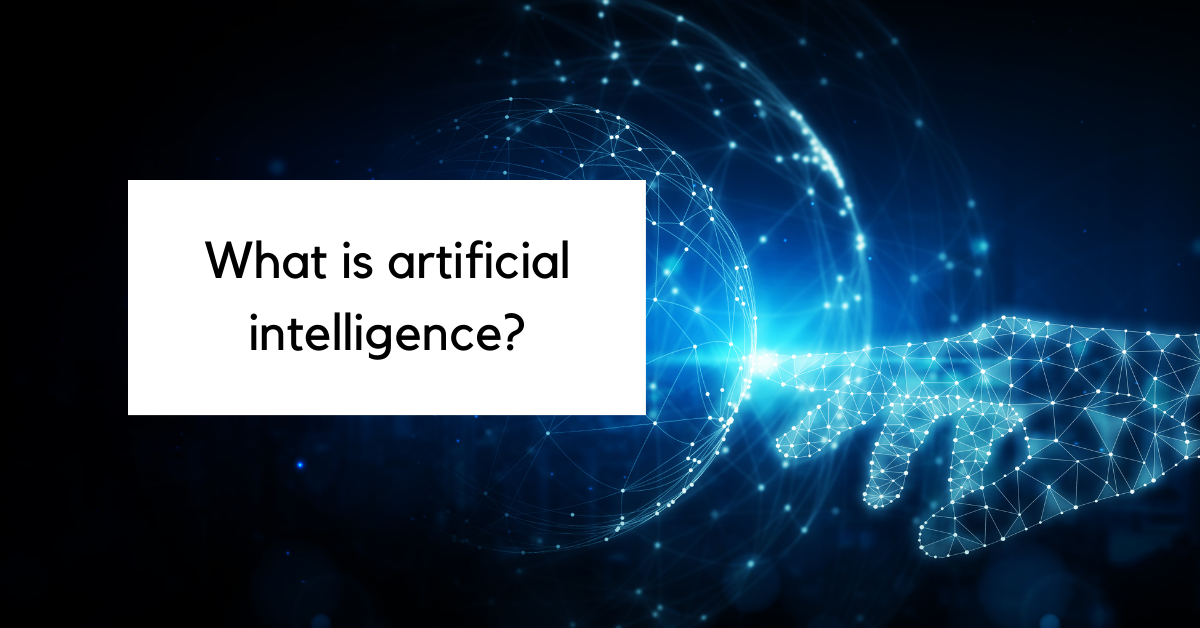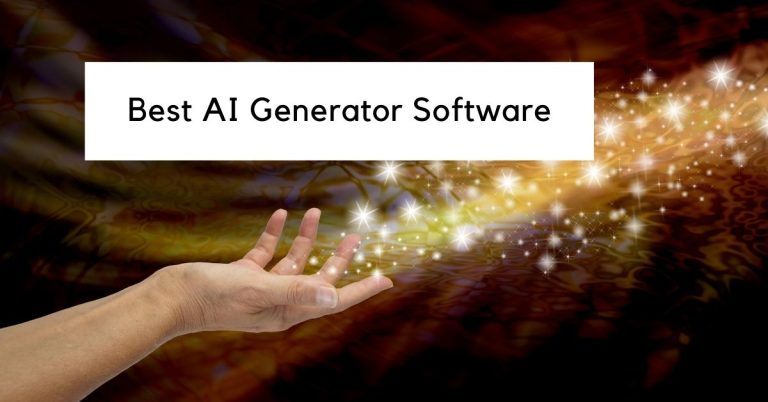Unpacking AI: Types, Applications, and Future Implications
As the world becomes more technologically advanced, artificial intelligence (AI) is playing an increasingly prominent role in our daily lives. From self-driving cars to virtual assistants, AI is transforming the way we live, work, and interact with the world. In this article, we will explore the different types of AI, their applications, and the future implications of this rapidly evolving field.
What is artificial intelligence?
AI is the development of computer systems that can perform tasks that would normally require human intelligence. These types of artificial intelligence include problem-solving, learning, perception, language understanding, and decision-making. AI systems can be designed to mimic human thought processes, improve upon them, or even develop entirely new ways of approaching problems.
The actual definition of artificial intelligence
Artificial intelligence can be defined as the ability of a computer system or machine to perform tasks that would typically require human intelligence. This may involve perceiving and understanding the environment, making decisions based on acquired knowledge, or processing natural language. AI systems are designed to learn from experience, adapt to new information, and improve their performance over time.
A brief history of AI
The concept of artificial intelligence dates back to ancient history, with myths and stories about artificial beings endowed with consciousness or intelligence. However, the modern field of AI research began in the mid-20th century with the development of electronic computers. Key milestones in the history of AI include:
- 1950: Alan Turing proposed the Turing Test, a measure of a machine’s ability to exhibit intelligent behavior.
- 1956: The term “artificial intelligence” was coined at the Dartmouth Conference, marking the official birth of the field.
- 1960s-1970s: Early AI research focused on symbolic methods and rule-based systems, known as “Good Old-Fashioned Artificial Intelligence” (GOFAI).
- 1980s: AI research shifted towards machine learning, a subset of AI that enables computers to learn from data and improve their performance.
- 1990s: The emergence of the internet and increased computational power allowed AI to expand into new domains, such as natural language processing and computer vision.
- 2010s: The rise of deep learning, a form of machine learning that uses artificial neural networks to model complex patterns in data, led to significant advancements in AI capabilities.
Categories of artificial intelligence

AI can be divided into two main categories: weak AI and strong AI. Each category has its own set of definitions, examples, and limitations, which we will explore below.
Weak AI
Definition
Weak AI, also known as narrow AI, refers to AI systems designed to perform specific tasks without possessing general intelligence. These systems are tailored to complete one task or a limited set of tasks, and they do not possess the ability to learn, adapt, or perform beyond their designated functions.
Examples
Examples of weak AI include:
- Siri, Alexa, and Google Assistant: These virtual assistants are capable of performing specific tasks like answering questions, setting reminders, and controlling smart devices, but they do not possess general intelligence.
- Recommendation systems: Algorithms used by Netflix, Amazon, and Spotify analyze user preferences and behavior to recommend content, products, or music.
- Facial recognition software: Systems used in security and social media applications can identify faces in images but are not capable of broader tasks like understanding emotions or predicting behavior.
Limitations
Weak AI systems have several limitations, including:
- Task specificity: They are designed for specific tasks and cannot perform beyond their designated functions.
- Lack of understanding: Weak AI systems can process data but do not possess genuine understanding or consciousness.
- Dependency on human input: Many weak AI systems rely on human input for training and optimization, making them less autonomous than strong AI systems.
Strong AI
Definition
Strong AI, also known as general AI or AGI (Artificial General Intelligence), refers to AI systems that possess human-like intelligence, enabling them to perform any intellectual task a full human brain can do. These systems are designed to understand, learn, and adapt across a wide range of tasks and domains.
Examples
While there are currently no true examples of strong AI in existence, several research projects and theoretical concepts hint at what strong AI could look like:
- OpenAI’s GPT series: Though still considered narrow AI, the GPT series of language models demonstrates an ability to perform a wide range of tasks, including translation, summarization, and creative writing, suggesting a step toward general AI capabilities.
- Artificial Neural Networks (ANNs): These computational models, inspired by biological neural networks, have shown potential for learning and adapting to a wide range of tasks, making them promising candidates for strong AI.
Limitations
Strong AI faces several challenges and limitations, such as:
- Computational complexity: Creating a system capable of general intelligence requires immense computational power and advanced algorithms.
- Ethical concerns: The development of strong AI raises ethical questions, such as the potential for AI systems to replace human workers or the implications of creating sentient machines.
- Uncertainty and unpredictability: As strong AI systems become more autonomous, controlling and predicting their actions becomes increasingly difficult, raising concerns about safety and accountability.
Types of Artificial Intelligence
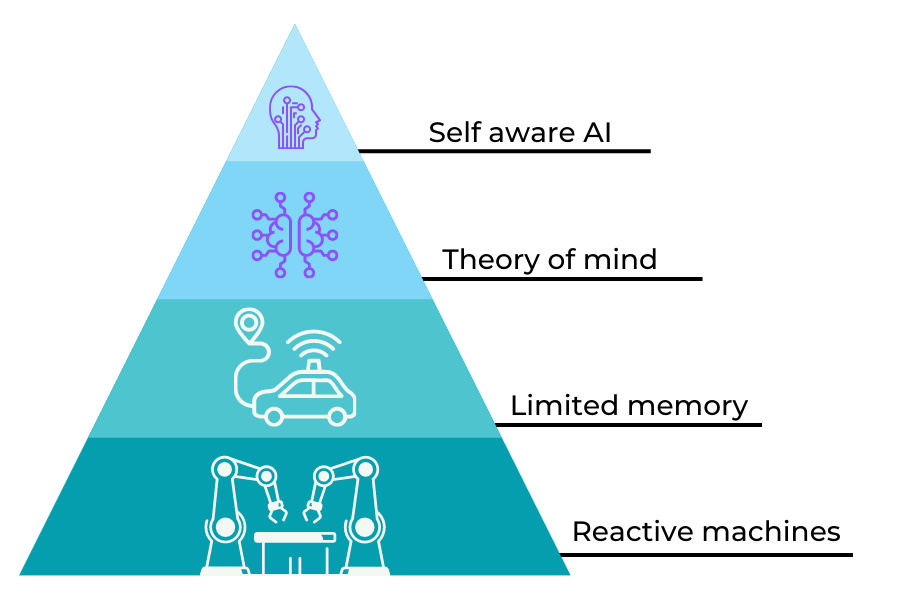
Apart from the categories of weak and strong AI, artificial intelligence can also be classified based on different levels of complexity and capabilities. The four types of AI in this classification are reactive machines, limited memory machines, theory of mind, and self-aware AI.
Reactive Machines

Definition
Reactive machines are AI systems that rely solely on their input to make decisions and take action. They do not possess the ability to learn from past experiences, create internal models, or anticipate the consequences of their actions.
Examples
- IBM’s Deep Blue: The chess-playing computer that defeated world champion Garry Kasparov in 1997 was a reactive machine, analyzing millions of possible moves and selecting the best one based on its programming.
- AlphaGo: Developed by DeepMind, AlphaGo is another reactive machine that defeated the world champion of the board game Go, relying on complex algorithms and vast search trees to determine its moves.
Limitations
Reactive machines have several limitations, including:
- No learning or memory: They are unable to learn from past experiences or store information for future use.
- Limited adaptability: Reactive machines cannot adapt to new situations or environments without being reprogrammed.
- Lack of foresight: They do not possess the ability to anticipate the consequences of their actions or plan for the future.
Limited Memory

Definition
Limited memory AI systems can retain and keep past data and utilize information from past experiences to inform their decision-making. However, the scope of their memory is restricted, and they can only store data for a certain amount of time.
Examples
- Self-driving cars: Autonomous vehicles rely on limited memory AI to process data from sensors and cameras, using past experiences to inform decisions like lane changes or braking.
- Chatbots: AI-powered chatbots can remember previous conversations with users and use that information to provide more personalized and context-aware responses.
Limitations
Limited memory AI systems face several challenges, such as:
- Memory constraints: The scope of their memory is restricted, which can limit their ability to learn and adapt over time.
- Dependence on human input: These systems often require human intervention for training, updating, and maintenance.
- Incomplete understanding: Limited memory AI may lack the depth of understanding needed to handle complex situations or generalize across different domains.
Theory of Mind
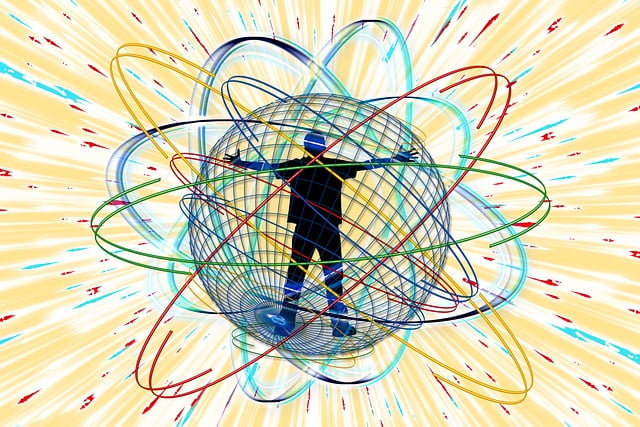
Definition
Theory of mind AI refers to systems capable of understanding and modeling the mental states, emotions, and beliefs of other agents, be they humans or other AI systems. This level of AI would enable machines to engage in social interactions and make decisions based on the perceived needs and intentions of others.
Examples
While there are no true examples of theory of mind AI currently in existence, ongoing research aims to develop AI systems with social and emotional intelligence, such as:
- Affective computing: A subfield of AI that focuses on designing systems capable of recognizing, interpreting, and responding to human emotions.
- Social robotics: The development of robots that can interact with humans in a socially appropriate manner, understanding and responding to social cues and norms.
Limitations
Developing theory of mind AI presents several challenges, including:
- The complexity of human emotions and behavior: Accurately modeling the mental states of others is a complex task that requires a deep understanding of human psychology and social dynamics.
- Ethical concerns: The development of AI systems with the ability to manipulate human emotions and beliefs raises ethical questions about privacy, consent, and the potential for misuse.
- Computational demands: Creating AI systems with a theory of mind requires advanced algorithms and significant computational resources.
Self-Aware
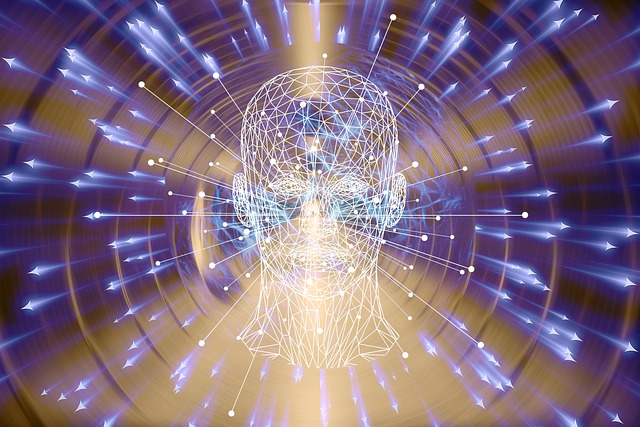
Definition
Self-aware AI refers to artificial intelligence systems that possess consciousness, self-awareness, and introspection. These artificial superintelligence systems would not only understand and model the mental states of others but also have a sense of their own existence, goals, and emotions.
Examples
Currently, there are no real-world examples of self-aware AI, as the development of such systems remains a theoretical concept and subject of ongoing research.
Limitations
The development of self-aware AI faces several challenges and limitations, including:
- Defining consciousness: Understanding and replicating consciousness in machines is a complex task, as the nature of consciousness itself is still not fully understood.
- Ethical and moral considerations: Creating AI systems with self-awareness raises numerous ethical questions, such as the rights and responsibilities of sentient machines, as well as the moral implications of creating and potentially controlling conscious beings.
- Technical hurdles: Developing self-aware AI requires advanced algorithms, computational resources, and a deep understanding of human cognition, emotions, and social behavior, making it a highly complex and resource-intensive endeavor.
Applications of AI
Artificial intelligence has permeated various aspects of our lives, revolutionizing industries and transforming the way we live, work, and interact with the world.
In the Tech Industry
AI has had a significant impact on the tech industry, contributing to advancements in several areas, such as:
- Natural language processing: AI-powered systems like chatbots, virtual assistants, and language translation tools have revolutionized the way we communicate and access information.
- Computer vision: AI algorithms enable machines to recognize, analyze, and process images and videos, driving advancements in facial recognition, object detection, and augmented reality.
- Cybersecurity: AI-driven solutions can identify and respond to cyber threats more effectively, protecting networks and data from unauthorized access and potential breaches.
- Data analytics: AI-powered analytics tools can process vast amounts of data, uncovering patterns and insights that help businesses make informed decisions and optimize their operations.
In Other Industries
AI has found applications across a wide range of industries, including:
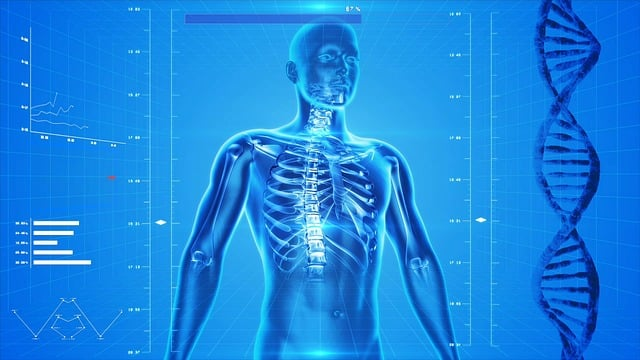
- Healthcare: AI is being used to improve diagnostics, predict patient outcomes, personalize treatment plans, and accelerate drug discovery, leading to more efficient and effective patient care.
- Finance: From fraud detection and credit scoring to algorithmic trading and customer service, AI is transforming the financial sector.
- Manufacturing: AI-powered automation, robotics, and predictive maintenance are optimizing manufacturing processes, increasing efficiency and reducing costs.
- Agriculture: AI-driven solutions are being employed to optimize crop yields, monitor soil health, and manage resources more effectively, ultimately contributing to increased food production and sustainability.
- Education: AI is being used to develop personalized learning experiences, adaptive assessment tools, and intelligent tutoring systems, enhancing the quality of education and supporting student success.
In Everyday Life
The influence of AI in our everyday lives is growing, with numerous applications making our daily routines more efficient, convenient, and enjoyable:
- Virtual assistants: AI-powered assistants like Siri, Alexa, and Google Assistant help us manage our schedules, answer questions, and control smart devices around the home.
- Social media: AI algorithms are responsible for content recommendations, friend suggestions, and targeted advertising on platforms like Facebook, Instagram, and Twitter.
- Online shopping: AI-driven recommendation systems help us discover products and services tailored to our preferences and needs on websites like Amazon, eBay, and Netflix.
- Navigation: AI-powered routing algorithms in GPS systems and mapping applications like Google Maps and Waze optimize our travel routes, reducing travel time and fuel consumption.
- Home automation: AI-driven smart home devices and systems, such as Nest thermostats and Philips Hue lighting, help create energy-efficient and comfortable living environments tailored to our preferences.
Concerns about AI
Despite its numerous benefits and applications, the rapid development and integration of AI have raised several concerns. These concerns encompass issues like bias and discrimination, privacy and security, job displacement, and ethical considerations.
Bias and discrimination
AI systems are trained on large datasets, and if those datasets contain biased or discriminatory information, the AI may inadvertently perpetuate those biases. This can lead to unfair outcomes in areas such as hiring, lending, or law enforcement, where AI-driven decisions could disproportionately affect certain groups of people.
Privacy and security

As AI systems become more prevalent and sophisticated, concerns about privacy and security of training data have grown. The increasing reliance on AI for data analysis and decision-making can lead to the collection and storage of vast amounts of personal information.
Job displacement
The automation of various tasks and industries by AI has led to concerns about job displacement. As AI systems become more capable and efficient, the need for human labor in certain roles may decline, potentially leading to job loss and social unrest.
Ethical considerations
The development and deployment of AI systems raise numerous ethical questions. These include the moral implications of creating sentient machines, the potential misuse of AI for surveillance or manipulation of human beings, and the responsibility and accountability of AI systems and their developers in the event of unintended consequences or harm. Addressing these ethical considerations is crucial to ensuring the responsible and equitable development of AI technology.
Future of AI
As artificial intelligence continues to evolve, its impact on various aspects of our lives is expected to grow exponentially. In this section, we will explore the potential for advancements in AI, its integration with other technologies, and its overall impact on society.
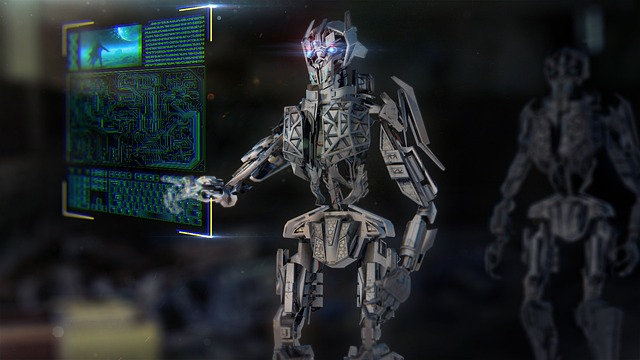
Potential for advancements
The field of AI is constantly advancing, with researchers exploring new algorithms, techniques, and applications. Future advancements may include:
- Improved algorithms: As AI research progresses, more efficient and effective algorithms will be developed, enabling AI systems to perform tasks with greater accuracy and speed.
- Enhanced learning capabilities: AI systems may become more adept at learning from limited data or in unsupervised settings, reducing the need for large, labeled datasets and human intervention.
- Breakthroughs in artificial general intelligence (AGI): Although still a theoretical concept, advancements in AI research may eventually lead to the development of AGI, enabling machines to possess human-like intelligence and perform a wide range of tasks.
Integration with other technologies
AI is likely to become increasingly integrated with other emerging technologies, creating new possibilities and applications:
- Internet of Things (IoT): The combination of AI and IoT can lead to the development of smart systems that optimize resource utilization, improve efficiency, and enhance decision-making across various industries.
- Quantum computing: Integration of AI with quantum computing has the potential to significantly accelerate computational capabilities, enabling AI systems to solve complex problems and analyze vast amounts of data in a fraction of the time required by classical computers.
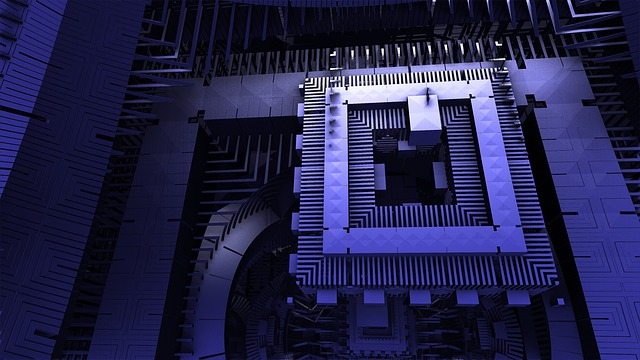
- Brain-computer interfaces (BCIs): Combining AI with BCIs could lead to advancements in fields like prosthetics, neurological rehabilitation, and human augmentation, ultimately improving lives and expanding human capabilities.
Impact on society
As AI becomes more advanced and integrated into various aspects of our lives, its impact on society will likely be significant:
- Economic transformation: AI has the potential to drive economic growth, streamline industries, and create new business opportunities.
- Education and skill development: AI will necessitate the development of new skills and educational programs to prepare the workforce for an AI-driven future.
- Ethical and regulatory considerations: The increasing influence of AI on society will require the development of ethical frameworks and regulations to ensure responsible and equitable use of the technology.
Final thoughts
The future of AI is full of promise and potential, with advancements in machine learning models and integrations set to transform industries, improve lives, and reshape the world as we know it. However, it also brings forth concerns and challenges that must be addressed to ensure responsible and ethical development. By understanding the evolving landscape of AI, we can navigate the complexities of this rapidly advancing technology and harness its potential for the betterment of society.

